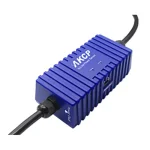A branch circuit is part of the electrical distribution wiring within a building. The branch circuit is connected to an individual Way within a distribution panel and protected by an individual circuit breaker or fuse. The branch circuit provides the electrical power and energy to connected devices.
Branch Circuit Monitoring
Branch circuit monitoring solutions for server rooms, datacentres and other building facilities areas allow users to monitor power usage for single and 3phase eletrical circuits including voltage (V), current (A), power factor (pf), load (kW) and energy usage (kWh), with a billable-grade accuracy of + / – 1%. With a branch circuit monitor power and electrical usage parameters can be continuously monitored for data analysis and modelling. The data gathered for each individual branch circuit monitored can be used to calculate and track Power Usage Effectiveness (PUE) and track how electrical power and energy usage responds to load profile changes and upgrades of critical infrastructure systems including uninterruptible power supplies, cooling, equipment loads and lighting systems.
-
Applications (40)
- Temperature & Humidity (30)
- Water Leakage Detection (26)
- Server Rack Monitoring (28)
- Hardwired Ethernet Devices (28)
- Wi-Fi Connectivity Units (8)
- Wireless Devices (13)
- Narrowband IoT Devices (4)
- GSM / LTE Comms (7)
- Battery Monitoring (7)
- Power Monitors (28)
- Security Monitors (26)
- Branch Circuits (2)
- Data Centres (7)
- Data Loggers (11)
- Data Aquisition Systems (11)
- Laboratories (18)
- Pharmaceutical (18)
- Accessories (159)
What Are The Benefits of Monitoring Branch Circuits?
There are 6 main benefits to monitoring branch circuits within buildings:
- Capacity Planning: within any building or critical area power usage can and will change over a 24hour period. Within a server room or data centre, server utilisation and loading will increase or decrease power demands. Within a building, seasonal changes can affect HVAC and lighting usage. Tracking branch circuit power allows for capacity planning and provides the data required for energy efficiency programs.
- Circuit Load Balancing: the electrical circuits and critical power path within a building and specific areas such as those running IT server operations, are designed within specific loading parameters (kVA and kW). Each element of the electrical distribution circuit is designed with for resilience and safety, with suitably sized cables and circuit breakers. Monitoring power usage helps to ensure phase-load balancing to prevent imbalances on electrical circuits which can lead to downtime, overheating, and present a fire risk.
- Business Continuity and Resilience: within the critical power path of a server room or datacentre, the uninterruptible power supply and PDUs, and automatic transfer switches and generators (where installed) have threshold kVA and kW ratings. Ensuring that load usage remains within these parameters, retains a safety level and ensures that resilience and business continuity are not compromised.
- Alarm Notifications and Risk Reduction: monitoring and comparing the gathered data against set threshold levels with a suitable system and reporting mechanisms allows for automatic notification alerts to allow corrective actions to be taken and prevent downtime.
- Accurate Billing: for colocation datacentres and other server rooms with shared facilities, monitoring individual branch circuits allows for accurate billing to clients.
- Energy Improvement Programs: with monitoring in place it is possible to measure the before and after effect of improvement programs. These can include adopting the latest energy efficient and eco-friendly uninterruptible power supplies, air conditioning and cooling systems. lighting and other building circuit related systems. Changes in operating practices can be monitored for their effectiveness. Examples include changing HVAC and lighting control timetables.
For more information please contact our Projects team.
Server Room Electrical Circuit Installation
In a server room there may be individual branch circuits run from a distribution panel for each of the major electrical systems installed. These can include cooling, lighting, fire suppression, server cabinets and general electrical sockets.
The distribution panel may be protected from power outages by a standby generator. More commonly a separate circuit is run from the distribution panel to a sub-distribution board which is protected by an uninterruptible power supply (UPS). This circuit provides power to the server racks. Individual ways are circuit breaker protected and cabled to provide power via an overhead tray or under a raised access floor to power distribution units (PDUs) installed within the server racks.
Each electrical circuit can be monitored using an inline or smart power distribution unit. All the circuits can be monitored at the branch circuit level using a branch monitoring solution.
For more information see our blog post on how to power server rack PDUS from a UPS system.

Earn SRE points on all online purchases with double points on selected products






























